Granada and Alhambra
2 March, 2008, 12:02 am in "Spain"
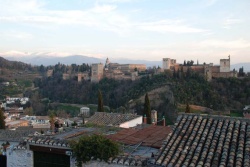 Descending through the mountains to Granada at sunrise was pretty but didn't improve my mood much after a sleepless bus ride from Barcelona. My mood did improve, however, as I walked though silent, twisting streets past Moorish architecture, looking for a place to stay. The situation was hopeless until after noon but at least I had a chance to enjoy the peaceful streets before they became thronged with people. One place offered to store our bags until a room was available at 2 PM.
Descending through the mountains to Granada at sunrise was pretty but didn't improve my mood much after a sleepless bus ride from Barcelona. My mood did improve, however, as I walked though silent, twisting streets past Moorish architecture, looking for a place to stay. The situation was hopeless until after noon but at least I had a chance to enjoy the peaceful streets before they became thronged with people. One place offered to store our bags until a room was available at 2 PM.Rowshan and I eagerly began exploring the town. One street took us alongside a stream below the Alhambra. A stone bridge arched over it.
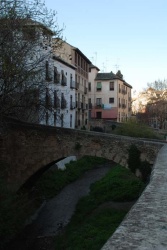
We wandered into a garden of one building and then up the hill through the Moorish quarter, noting keyhole arches and beautiful ceramic and stone ornamentation.
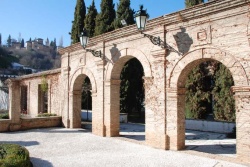
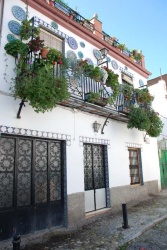
The atmosphere was very peaceful and relaxed with whitewashed walls and fruit trees.
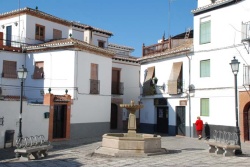
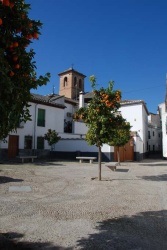
We found a couple different viewpoints from which we could see the Alhambra against a backdrop of snow blanketed mountains.
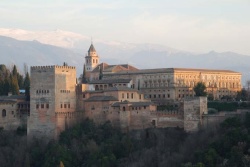
By this time things were getting crowded. At the St. Nicolas viewpoint, a chaotic blend of neo-hippies selling jewelry or busking and tourists, lounged admiring the view and the atmosphere.
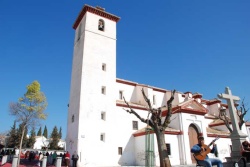
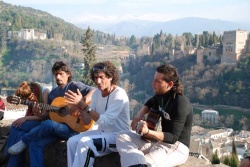
There was a flamenco band who set the mood.
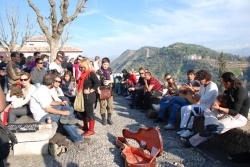
After all, Granada is considered the birthplace of flamenco. We briefly took a walk along the Sacremonte Road, passing flamenco bars and cave houses where the Roma people had settled and created bars for flamenco music and dance.
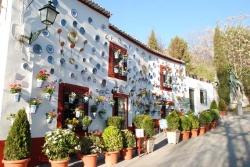
Then we returned to the viewpoint to admire the sunset.
From the distance, the Alhambra, though beautiful, still looks like other European Medieval fortresses. The only hints of its Islamic origins are an occasional window or arch where the telltale keyhole shape is visible. Our first glimpse of the Alhambra close-up was of the walls and a purely Islamic ornate gate. Rowshan said as soon as he saw it he expected an army of Moorish horsemen to come pouring through it.
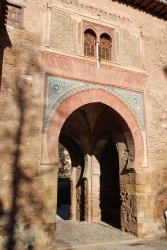
Soon we left the stone exterior and entered the lace-like interior of the Nasrid Palaces. Everything about the inside of the palaces makes one want to stop and look. From the first doorway it draws you into an incredible world of decoration. In the first room I started felling overwhelmed.
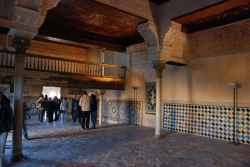
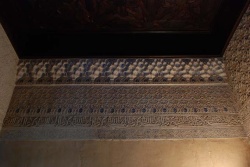
Our tickets only allowed us half a day in the Alhambra and it would take ages to absorb everything. There are geometric tile mosaics in yellow, blue and green and lots of intricate gesso work consisting of Kufi calligraphy and tezhip floral patterns.
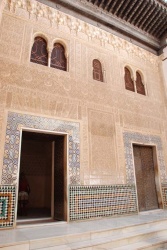
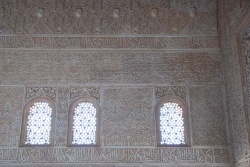
The columns have ornate capitals which resemble an optical illusion of arches rising into more arches, all dripping with lace-like gesso work.
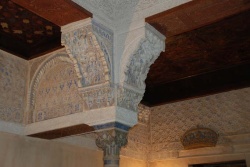
The ceilings contain patterns in wood. There are also beautiful ornate arched windows that draw the eye to tranquil gardens below.
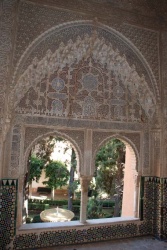
I guess at one point all the gesso would have been painted but now it is cream colored and shiny so it looked like ivory.
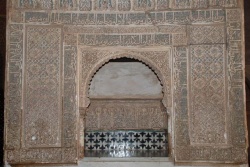
Above each doorway there was a passage from the Koran or names of the prophets, martyrs and their families, written in beautiful calligraphy and surrounded by patterns and flourishes.
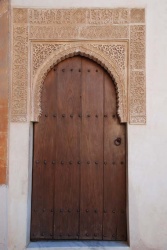
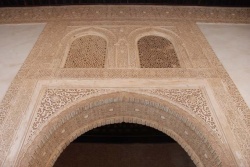
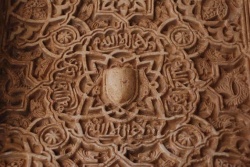
Birds had nested in some of the lace like designs above the doorways to the courtyard.
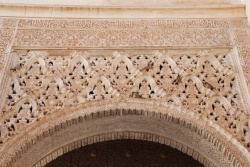
In the center of one of the palaces there was a beautiful reflecting pool.
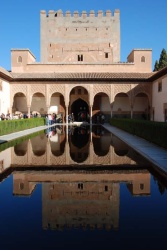
It is hard to write about the Alhambra because words don't give it credit. The photos I'd seen hadn't prepared me for it either. I found myself wondering, as a designer, how it all could work. How can so many different patterns not drive the eyes mad? Why does it make me feel calm instead of frantic? Why is it so beautiful? The decorations seem to pull the eye upward and perhaps that is the calming effect-- lifting the viewer out of the mad crowd of awestruck visitors, into a pattern like shifting clouds.
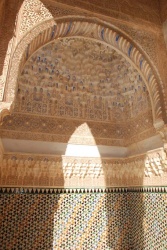
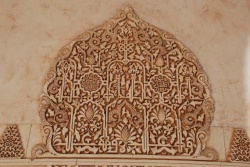
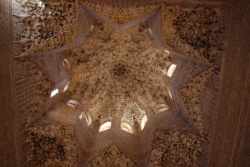
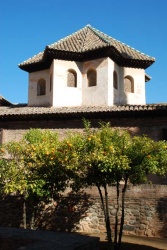
The other parts of the fortress were rather dull after seeing the palace. However, the Generalife Palace had some nice features, views and gardens.
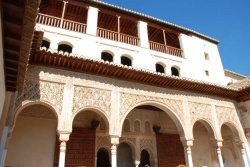
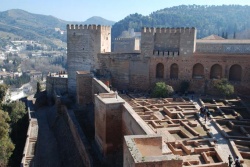
We spent the rest of our visit to the complex wishing we had stayed longer in the Nesrid Palaces... longing to go back but knowing we couldn't since our ticket only allowed us to enter it during a half hour window.
In the afternoon we took a walk up Sacremonte where we passed some newer cave houses where people were living. Then we descended into a garden and, after all our walking, Rowshan was relieved to soak his feet in a fountain.
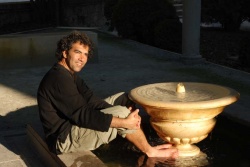
Later while walking around another part of town, we unexpectedly came upon a familiar statue, Rodin's Thinker.
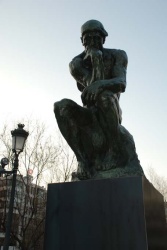
Beyond him were a bunch of other Rodin bronzes that had been installed in the center of town for a temporary exhibition. Then we noticed the setting sun was casting a golden light on some church steeples. A closer look brought us to a promenade with cafes and a bandstand where people were learning how to tango. There was also a fountain featuring Rowshan's favorite fruit, the pomegranate.
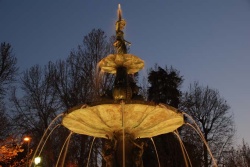
He had been dismayed to notice around the town, a couple trees where pomegranates had been left untouched on branches until they spoiled. I guess there are no Persians in Granada.

Comments
- Comments
Powered by My Blog 1.69. Copyright 2003-2006 FuzzyMonkey.net.
Created by the scripting wizards at FuzzyMonkey.net..
(Code modified by Rowshan Dowlatabadi)
Created by the scripting wizards at FuzzyMonkey.net..
(Code modified by Rowshan Dowlatabadi)

